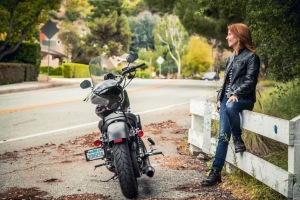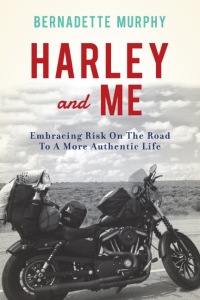Harley and Me by Bernadette Murphy
published by Counterpoint Press, May 2016

Harley and Me is a memoir about what it means to take risks. For Murphy, her risk-taking most noticeably began when she was a skateboarder in California. But a teen pregnancy followed by her baby’s adoption led Murphy into the arms of safety: marriage at 22 to a stable guy, 3 kids, house, university job, and what she calls a blanket of estrogen that kept her from doing anything too risky. But at 48 and contemplating divorce, Bernadette Murphy feels something unusual — something she wouldn’t image over the past 25 years of wife and mother — she wants to be fully alive, fully present, and not risk averse. Furthermore, she doesn’t want to do a “song and dance” to please men anymore.
I’ve been a passenger on motorcycles for 26 years. My parents have been riding my whole life. Before that, it was my paternal grandparents. You could say it’s a family thing! Go through my thousands of family photos and you’ll find dozens of motorcycle pictures from through the years, including strangers’ motorcycles (hey, if a bike looks good, you never want to forget it).
Far left: me leaning on my brother’s motorcycle circa 2004. Going to the right is my dad, brother, and granny on their newest rides circa 2016.
But Harley and Me is about a middle-aged woman getting a motorcycle, which isn’t terribly common — unless you’re my mom. Which is why I felt a great desire to read Murphy’s book when it popped up in my Twitter feed. I wanted to see how other women with nearly grown children felt about driving a “death machine,” as some paranoid people call them (as if we don’t die in cars).
Left: my sweet ma as passenger in the early 80s. Right: 4 motorcycles and 120,000+ miles later, my sweet ma today with her own award-winning motorcycle. I love the skeleton hands on the mirror!
Murphy really captures what it means to start riding a motorcycle. Her good friend Rebecca inherited a Harley dealership, which is how Murphy is lured into signing up for her motorcycle license. First, she must attend a week-long class. While most people have down the “look” of a biker (and I see this all the time — people who don’t own a motorcycle but do own an entire closet of leather and Harley-Davidson T-shirts), Murphy feels she does not. She shows up to class:
In baggy men’s Levi 501s, a stained T-shirt, gardening gloves, and hiking boots. I look more like a hired hand than a biker chick. At this moment, I’d love a pair of killer motorcycle boots.
Because I get what Murphy is saying about “the look,” I really enjoyed her descriptions and comparisons. Even when she dumps her bike the first time, she makes the scene come off the page:
I sit on the curb in front of the gas station’s convenience store. My hands shake. My mouth is dry. It feels as if all my blood has been exchanged for electricity. I am awash in shame. I don’t look like the badass biker chick I’m trying to become, but some kind of poseur who can’t control this machine, a pathetic girl trying to do something beyond her ability.
Here, I really felt for Murphy. Though pretty much everyone dumps their bike at one time or another, a woman doing so with witnesses serves as evidence that motorcycles are just “too much” for women. It’s scary to face those people shaking their heads, Murphy notes, wondering if she’s gone crazy and this is her mid-life crisis. A year later, she is divorced,and people wonder if the “crisis” caused Murphy to give up stability and comfort. The ability to take a chance, change her life, and try something brave had me nearly in tears for how safe and squishy I want to make my own life — truthfully, I felt like a wuss.

Harley and Me provides plenty of commentary on feminism. Sometimes a whole book on feminism can be great, but when it’s woven into a personal narrative, the author can accomplish connections that might otherwise seemed forced. For instance, Murphy shares her love of Fonzie. Later, when talking to a male biker, he says he wishes he were the Fonz, and Murphy says she wanted to date the Fonz. But as the conversation changes direction, Murphy boldly confesses:
Actually, I take that back….I wanted to be Fonzie, too.
If Fonzie is cool, powerful, and slick, is he only a role model for men? Murphy proves no, and again I related to her inner complications about assigned gender roles. I often wished I had the power and energy and chaos that the men in my favorite rock bands, like the guys in Metallica, or Chris Cornell, or Tom Morello. Don’t we all wish to be seen and in control? For women, being seen is harder than men might think. We’re either invisible or on display like a prize cow.
Murphy breaks down stereotypes of women on bikes and how she doesn’t fit:
Just to get on a bike is to break prescribed gender roles even in this postfeminist age. By taking it one step further, refusing to be constricted by the typecast of the sexy biker mama or the hard-ass butch rider, is to accept one’s true sense of self. I like my motorcycle simply because I like to ride.
Her examination of stereotypes comes up again and again when she notes that her friend drives a pink motorcycle with Barbies attached to the sides, so everyone pays attention to her (and wants pictures). At biker events, women are almost always on the back (known as the “bitch seat” in biker culture) and are sure to have lots of skin showing, riding along in ridiculous spiked heels. After her divorce and bonding experience with her motorcycle, Murphy realizes she has a strong libido, and that to embrace it is not promiscuous or doing men a “favor,” but has to do with sex in biker culture.
There is a lot of useful information in Harley and Me, but this isn’t a book about discovering the love of riding. It’s about risk-taking. Murphy shares many (perhaps too many) articles and studies on the effects of taking risks on brain chemistry, how we strive our whole lives to create safety, but when safety is assured, our brains grown sluggish. We lack the brain chemistry that comes from risks, like learning a new language, taking up an instrument, sky diving, competing in a sport, getting a new job, dating, changing homes — or riding a motorcycle. I felt less wuss-like when I learned that “risk” isn’t defined by the activities from the X-Games; it’s what we personally consider risky.
I appreciated all the research Murphy did, but it really slowed down the memoir. Chapter 8 was terribly slow when she explained risk taking in a scientific sense, because she keeps explaining it. Basically, once we do something that makes us anxious because we took a risk, we get a hit of feel-good chemicals and want to do it again. This concept is restated at least a dozen times over the next 150 pages.
Part of reinforcing the theory that taking risks has made Murphy a dopamine fiend comes from personal evidence. There are many scenes in the 3rd part of the book: Murphy living in French Polynesia for three months, Murphy running a marathon there, scuba diving in the ocean, paddle boating, rock climbing, ice climbing. Each example comes with its own descriptions of how afraid she was, how she knows she can conquer fear, and how taking the risk will make her take new risks because she received those feel-good chemicals. Science was scattered throughout this section, too, and the book got so repetitive that I was forgetting the focus was Murphy’s relationship with her Harley-Davidson. I felt impatient and spacey.
The book ends with Murphy reiterating all the risks she’d experienced (though I’d just read them!) and taking a blood test to see if riding a motorcycle increases oxytocin. It was more science to prove that riding a motorcycle changed her life because it changed her chemistry, but I didn’t need it. I wanted more personal insights, more intense description that came earlier in the book, both when she described her current life and childhood. Including the numerous typos I spotted, I felt a stronger editor could have culled the best parts and made this into an educational, inspiring, feminist memoir.
I want to thank Bernadette Murphy and her publicist at Counterpoint Press for sending me a reviewer’s copy in exchange for an honest review. To learn more about Murphy’s writing, please check out her Meet the Writer feature!

#20BooksofSummer
This book was read as part of Cathy 746‘s challenge to read 20 books between June 1st and September 5th.







I reread the interview and I’m guessing she’s more interested in the science than in the feminist memoir. I’m certainly happy to blame all the silly things I did in my 40s on brain chemistry! Did you query her about this?
LikeLiked by 1 person
I saw something about the book on Twitter, so I asked if I could have a review copy and interview her. I often like to do both, if I can, so that the author can get in her own say about her writing life. That way, if I don’t love a book, maybe the author’s interview will convince someone who doesn’t agree with me that they WOULD like the book.
LikeLike
Sounds so wow! I wish I could take off on a bike 😊
LikeLiked by 1 person
It’s a tough go. I remember my mom’s motorcycle instructor said she drove like a girl when they were practicing on the course, and she started crying. Then she drove really fast and skidding to a halt, (which was the exercise), and, at least in my imagination, gave that guy the middle finger.
LikeLiked by 1 person
She sounds awesome!
LikeLiked by 1 person
Thanks so much! She’s pretty brave.
LikeLiked by 1 person
My life also seems wuss-like compared to hers. But, then again, I still have a few more years before it could take the turn hers did – I think I’m still in full-on estrogen mode. I don’t know if I’m hoping my life will get ‘riskier’, or not.
LikeLiked by 1 person
Yeah, and your kids are pretty small compared to her. Her youngest was a senior in high school. I felt very wuss-like in comparison, too, which gave me a lot of feelings about the book that made me involved. But the science kept coming back — pretty much the same science! — which I found distracting. Give it a read, Naomi! Canada is also know for great motorcycle rides!
LikeLiked by 1 person
It was interesting to hear about your biker-family. Mine is definitely not a biker-family!
LikeLiked by 1 person
Thanks! I totally stuck out in school when my dad would come pick me up after orchestra on a motorcycle! I can’t say I minded the attention, especially when the super hot guy everyone had a crush on said I was cool.
LikeLiked by 1 person
[…] GTL: Thanks so much for visiting Grab the Lapels to share with readers who you are! Read my review of Murphy’s newest book, Harley and Me, HERE. […]
LikeLike
Shame the book got a bit bogged down in the science. I’ve only been on a motorbike a couple of times – once as a passenger and once on a very low power one as a rider for a short run round the pathways of the geriatric hospital I worked in at the time! I don’t think it was really me who was “at risk” that day! 😉 I must admit it terrified the life out of me – both experiences – and I retreated quite happily back into wuss-dom thereafter…
LikeLiked by 1 person
I’ve ridden for many, many years, but as I get older (I’m 31), things scare me more. I must be right in the thick of my estrogen blankey.
LikeLiked by 1 person
Also, I would be super happy if you had pictures of you on a motorbike in front of a geriatric hospital! 😀
LikeLike
Haha! Sadly not – way back in the days before phones with cameras. In fact, way back before cell phones at all! (Soon I might be back in that geriatric hospital… 😉 )
LikeLiked by 1 person
Reblogged this on Don Massenzio's Blog.
LikeLike
This sounds so like a good editor could have pulled out the memoir and lost some of the detail and repetition, what a shame (or there was a good editor but the author and publisher ignored their advice, which is always possible, as I know somewhat to my own cost …) I will look out for this but with reservations. Thank you for your insightful and honest review.
LikeLiked by 1 person
I think it’s worth reading. It’s mostly the third section when I wanted things to wrap up, but instead she did many adventurous things and explained them all with the science again. The first section is valuable to women of any age, in my opinion, so if you find the book, read at least that part!
LikeLiked by 1 person
What a fascinating glimpse into biker life and I especially loved that you shared your connection 🙂 I’d definitely read something like this if the feminist memoir angle is strong enough, even if I prefer my more quiet life! The science sounds quite fascinating, too, but I can see how it would distract from the core of the book if it’s repeated in later chapters.
LikeLiked by 1 person
It’s worth a read, even if it gets a bit repetitive in the end!
LikeLiked by 1 person
It’s a shame about the repetition. But I’m really fascinated by the feminist side of the book, specifically how Murphy found being in a traditionally male-dominated space where women have really defined roles. I saw a lot of women being similarly pigeon-holed when I was heavily into cycling (the un-motored kind), but also some really strong initiatives by women working to break down those stereotypes. Also, I didn’t know you and your family were into motorbikes! I loved seeing all your pics!
LikeLiked by 1 person
Thanks, Margot! I think the book is with a read; just know that the last section is where it drags.
LikeLiked by 1 person
[…] Harley and Me by Bernadette Murphy […]
LikeLike
[…] Harley and Me by Bernadette Murphy […]
LikeLike
[…] Harley and Me by Bernadette Murphy […]
LikeLike
[…] Harley and Me by Bernadette Murphy […]
LikeLike
[…] Harley and Me by Bernadette Murphy […]
LikeLike
[…] Harley and Me by Bernadette Murphy […]
LikeLike
[…] Harley and Me by Bernadette Murphy […]
LikeLike
[…] Harley and Me by Bernadette Murphy […]
LikeLike
[…] Harley and Me by Bernadette Murphy […]
LikeLike
[…] Harley and Me by Bernadette Murphy […]
LikeLike
[…] Harley and Me by Bernadette Murphy […]
LikeLike
[…] Harley and Me by Bernadette Murphy […]
LikeLike
[…] Harley and Me by Bernadette Murphy […]
LikeLike
[…] Harley and Me by Bernadette Murphy […]
LikeLike
[…] Harley and Me by Bernadette Murphy […]
LikeLike
[…] Harley and Me by Bernadette Murphy […]
LikeLike
[…] Harley and Me by Bernadette Murphy […]
LikeLike
[…] Harley and Me by Bernadette Murphy […]
LikeLike